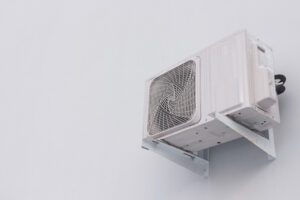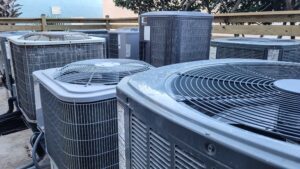Introduction to Climate Control Systems
Choosing the right climate control system for your commercial space is key to not only maintaining a comfortable environment but also in saving on energy costs and increasing the efficiency of your building. At its core, a climate control system manages the heating, cooling, and air quality in a space. There are two main types you might consider: a Centralized system, which controls the climate of the entire building from one central location, and a Decentralized system, where individual units manage different sections or rooms. Your choice depends on the size of the space, energy efficiency needs, and budget. Keep in mind, the right system will make a huge difference in creating an optimal work or customer environment. Let’s dive into the specifics to help you make an informed decision.
Assessing Your Commercial Space Needs
Before diving into the ocean of climate control systems, take a step back and evaluate what your commercial space truly needs. Think size, think structure. A small cafe won’t have the same needs as a sprawling office building. It’s not just about square footage; ceiling height, insulation quality, and sun exposure play massive roles too. Consider the layout – open areas cool down differently than segmented spaces full of rooms and corridors. Now, think about what happens inside your space. A gym, with its high human activity, has different climate control needs compared to a quiet bookstore. Evaluate foot traffic, machinery heat output, and any specific requirements your business type demands. This check-list acts as your compass, guiding you through the sea of options to find the perfect climate control solution that matches your commercial space’s unique fingerprint.
Types of Climate Control Systems Available
When picking a climate control system for your commercial space, you have a few options to consider. Central air conditioning is a common choice, keeping the whole building at a consistent temperature. It’s good for large spaces but can be pricey to install and run. Ductless mini-split systems offer flexibility since they can heat or cool different areas independently without needing ductwork. These are cost-effective for smaller spaces or where individual room control is needed.
Then there’s evaporative coolers, which are energy-efficient and work best in dry climates. They use water to cool the air, offering a more eco-friendly solution. However, they might not be effective in humid areas. Window units are a budget-friendly option for small spaces or as a temporary solution but might not be practical for cooling large commercial spaces. Each system has its pros and cons depending on your space size, budget, and cooling needs. So, consider what’s most important for your business when making a choice.
Factors to Consider When Choosing a Climate Control System
When choosing a climate control system for your commercial space, several key factors come into play to ensure you pick the right option. First, consider the size of your space. The capacity of the system needs to match your area to efficiently control the climate without overworking. Second, think about energy efficiency. Opting for a system with a higher efficiency rating can save you money on energy bills in the long run. Third, don’t forget about maintenance. Some systems require more upkeep than others, so choose one that fits your ability to maintain it. Fourth, consider the type of system. Whether it’s centralized or split systems, each has its pros and cons depending on your space’s layout and needs. Lastly, take into account the initial cost versus long-term benefits. Sometimes spending more upfront can lead to greater savings down the line. Keep these factors in mind to make an informed decision that meets your commercial space’s unique demands.
Energy Efficiency and Sustainability in Climate Control
When it comes to picking a climate control system for your commercial space, energy efficiency and sustainability aren’t just fancy buzzwords; they’re crucial for cutting costs and respecting our planet. The right system can significantly reduce your energy bills. Look for systems with a high Seasonal Energy Efficiency Ratio (SEER) rating. The higher the SEER rating, the more efficient the system. Also, consider systems that use eco-friendly refrigerants. These have a lower impact on the environment compared to traditional refrigerants. Remember, investing in energy-efficient and sustainable climate control solutions is not just good for the earth; it’s smart for your business’s bottom line.
The Role of Technology in Climate Control Solutions
Technology plays a critical role in climate control solutions for commercial spaces. Today, advancements in technology have led to the creation of sophisticated systems capable of maintaining the optimal environment, ensuring both comfort and energy efficiency. Smart thermostats and automated systems can now learn your space’s usage patterns, adjusting temperatures and airflow accordingly. This not only provides a consistently comfortable atmosphere but also helps in cutting down energy costs. Moreover, IoT (Internet of Things) enabled devices allow for remote monitoring and control, giving you the ability to manage your climate control system from anywhere. The role of technology in climate control solutions is about more than just convenience; it’s about creating sustainable, efficient environments that adapt to our needs.
Cost Considerations and Budget Planning
When picking a climate control system for your commercial space, the cash you’re willing to part with plays a big role. Here’s the lowdown: Generally, the setup bill for these systems isn’t chump change. It hops around based on the type of system you choose, the size of your space, and the complexity of installing it. For starters, basic systems might dent your wallet less at the beginning but can end up costing more in the long run due to higher energy bills or maintenance costs. On the flip side, high-efficiency models come with a steeper price tag upfront but tend to save cash on operating costs.
Chunk your budget down to avoid surprises. Break it into upfront costs (purchase and installation) and ongoing costs (energy consumption, maintenance, and repairs). Remember, cheap out now, and the system may haunt your bank account later with endless repairs and shocking energy bills. A beefy, energy-efficient system might gulp more money initially but can clinch costs down the road, making it a savvy move. So, eyes on the prize: a system that balances upfront costs with long-term savings. Adjust your budget with long sight; don’t let the initial sticker shock blind you to potential savings. In the game of climate control, playing it smart with your budget can lead to significant victories in comfort and costs.
Installation and Maintenance Requirements
Installation and maintenance are key when choosing a climate control system for your commercial space. First off, the system must fit your space perfectly. If it’s too small, it won’t cool or heat effectively. Too large, and you’re wasting energy and money. Installation costs can vary widely, so get a few quotes. Look for professionals with experience in commercial installations. They should understand your needs and offer a solution that aligns with your space and budget. Maintenance-wise, regular checks are crucial. Some systems need more upkeep than others. For instance, central air systems require filter changes and duct cleaning, while split systems might need less frequent maintenance. Cost can be a factor here. A system with high upfront costs but lower maintenance might save you money in the long run. Always consider the long-term maintenance requirements and costs when making your choice.
Case Studies: Successful Climate Control Implementations
Many businesses have reaped the rewards of choosing the right climate control systems, and their stories can guide yours. For instance, a popular retail chain saw energy bills plummet by 20% after installing an advanced HVAC system that adapts to both seasonal changes and daily customer flow. They chose a system with smart technology that learns and adjusts, proving efficiency is key. Another case is a large office building where employee productivity boosted after improving air quality and temperature control. They went for a system that offers individual zone controls, allowing different areas to be set to different temperatures. This flexibility meant employees were more comfortable and, as a result, more focused and efficient. Lastly, a manufacturing plant faced constant issues with humidity affecting their production line. By implementing a climate control system designed for large, open spaces with high humidity challenges, they not only protected their products but also improved working conditions for their staff. These examples underline the importance of understanding your space’s unique needs and investing in a system that caters to those while also opening the door for potential energy savings and productivity boosts.
Conclusion: Making the Right Decision for Your Space
Choosing the right climate control system for your commercial space is not just about picking a heating and cooling solution. It’s about investing in comfort, productivity, and energy efficiency. Let’s wrap up. Think about the size of your space, your budget, and the specific needs of your business. Are energy efficiency and sustainability important to you? Then, lean towards systems with high Energy Star ratings. Is installation cost a concern? Remember, sometimes spending a bit more upfront on a system can mean lower operating costs down the line. Don’t forget to consult with professionals. They can offer insights specific to your climate and building type. Lastly, consider future needs. A system that’s scalable might be more cost-effective as your business grows. Making the right decision now sets you up for long-term savings and comfort.




